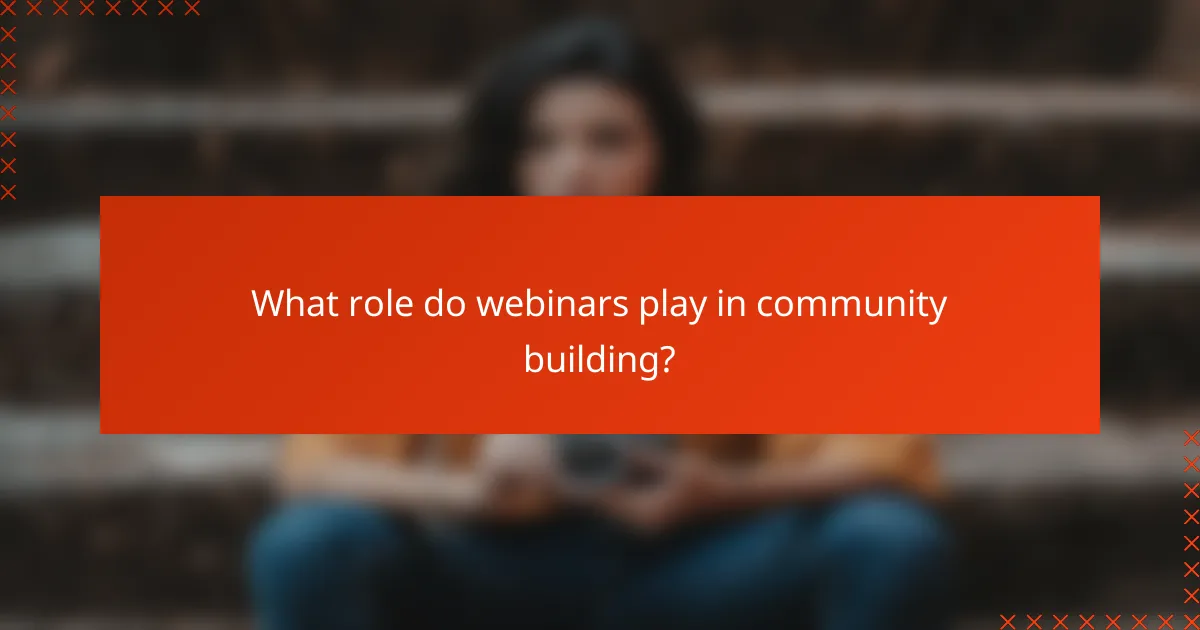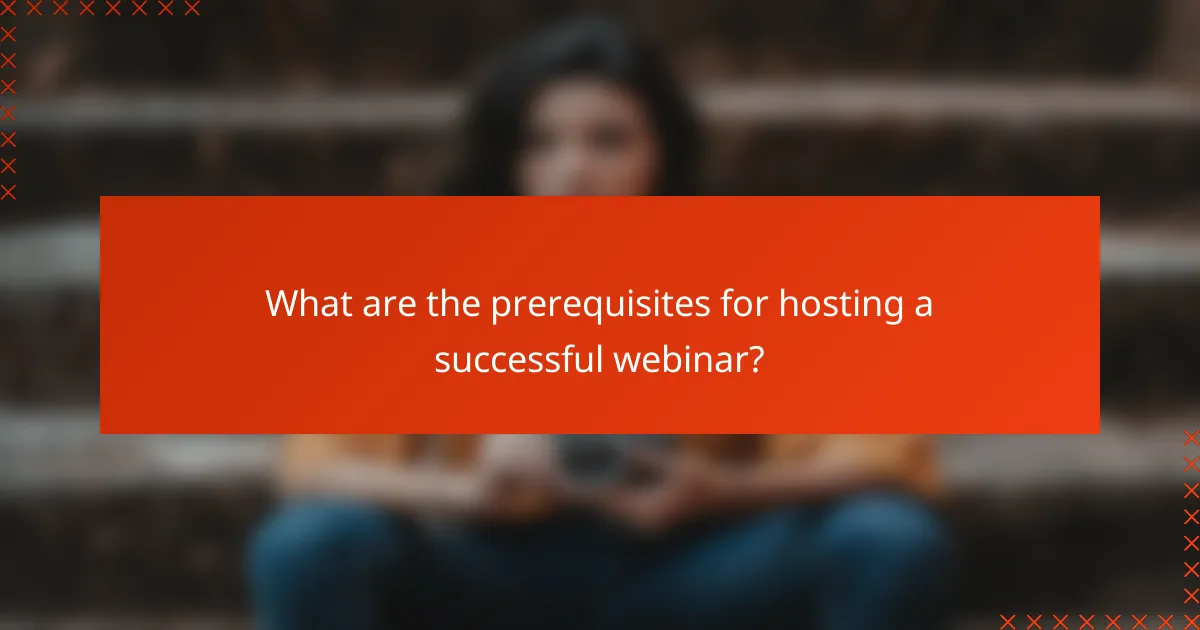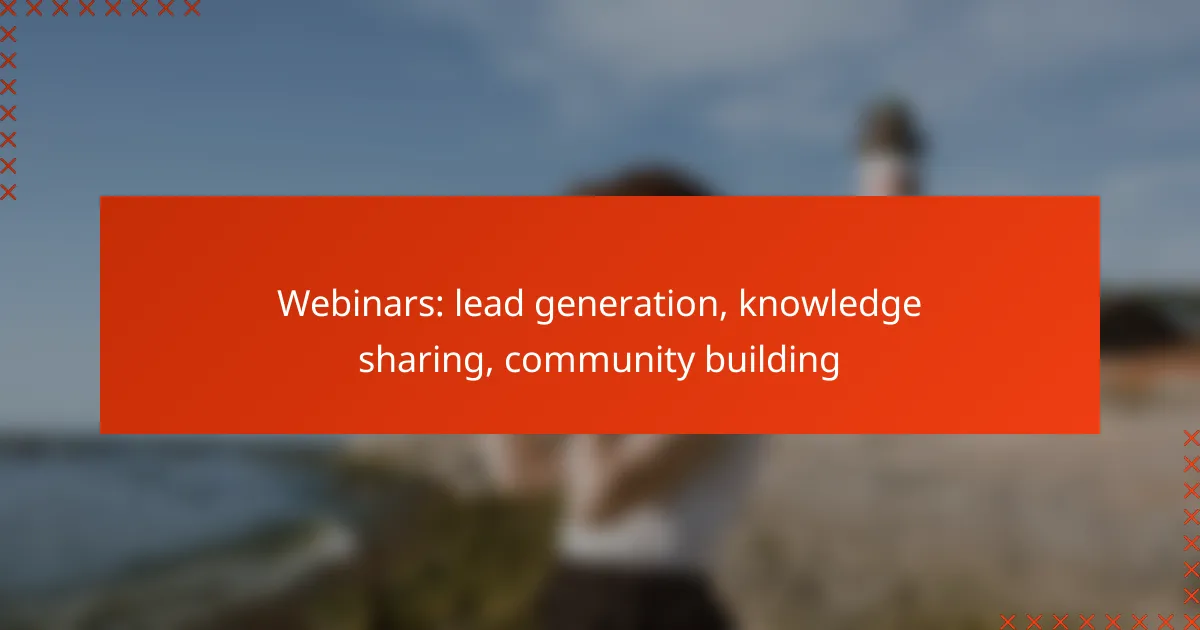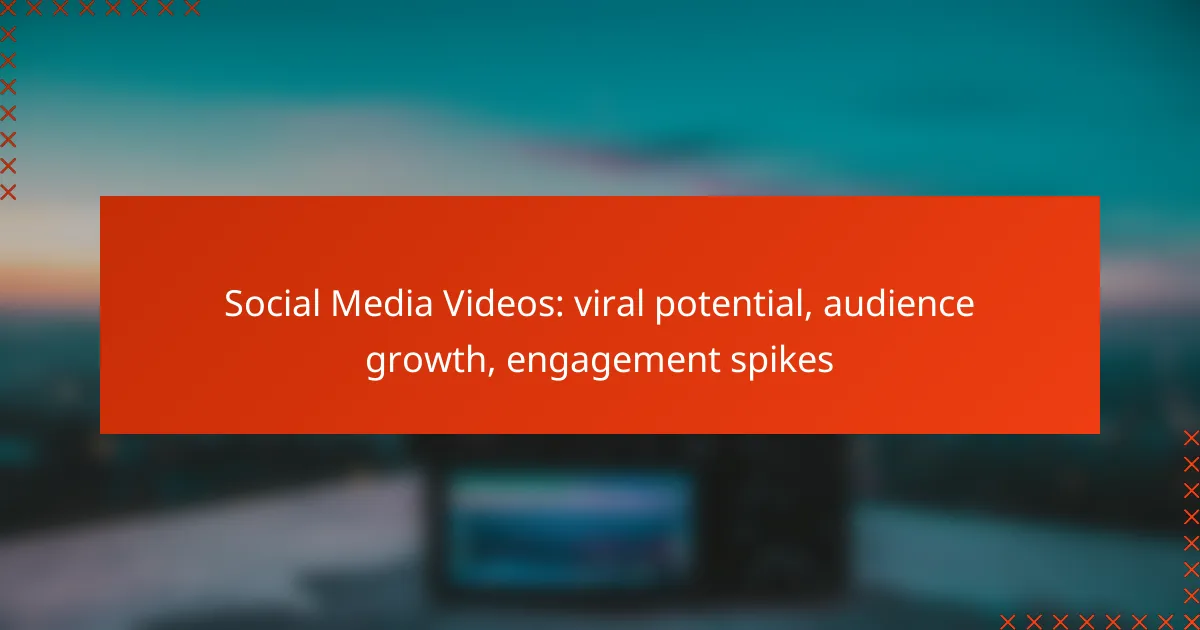Webinars serve as powerful tools for lead generation, knowledge sharing, and community building by delivering valuable content that attracts and engages potential customers. By fostering interactive learning experiences, businesses can establish trust and connections with their audience, ultimately driving conversions. Selecting the right platform enhances audience engagement and facilitates effective follow-up, maximizing the impact of your webinars.

How do webinars generate leads in the United States?
Webinars generate leads in the United States by providing valuable content that attracts potential customers and encourages them to engage with a brand. By offering insights, education, or entertainment, businesses can build trust and establish connections with their audience, ultimately leading to increased conversions.
Targeted audience engagement
Webinars allow businesses to engage with a specific audience interested in their products or services. By promoting the webinar through targeted marketing channels, companies can attract attendees who are more likely to convert into leads.
Utilizing platforms like social media, email marketing, and industry forums can help reach the right demographic. Tailoring the content to address the audience’s pain points fosters a deeper connection and encourages active participation.
Data collection through registration
During the registration process, businesses collect valuable data from attendees, such as names, email addresses, and job titles. This information is crucial for segmenting leads and tailoring follow-up communications to their specific interests and needs.
Implementing a simple registration form can significantly enhance lead generation efforts. Consider including questions that help identify the attendee’s challenges or goals, which can inform future marketing strategies.
Follow-up strategies for conversion
After the webinar, effective follow-up strategies are essential for converting leads into customers. Sending personalized thank-you emails that recap key points and provide additional resources can reinforce the value of the webinar.
Consider segmenting your follow-up emails based on the data collected during registration. This allows for targeted messaging that addresses specific interests, increasing the likelihood of conversion. Additionally, offering exclusive promotions or consultations can further entice attendees to take action.

What are effective webinar platforms for lead generation?
Effective webinar platforms for lead generation provide tools that enhance audience engagement, track participation metrics, and facilitate follow-up communication. Choosing the right platform can significantly impact your ability to convert attendees into leads.
Zoom for interactive sessions
Zoom is well-known for its user-friendly interface and interactive features, making it ideal for engaging webinars. It allows for real-time polls, Q&A sessions, and breakout rooms, which can enhance audience participation and retention.
When using Zoom, consider scheduling sessions at times that accommodate your target audience’s availability. Aim for sessions that last between 30 to 60 minutes to maintain attention while providing valuable content.
GoToWebinar for analytics
GoToWebinar excels in providing detailed analytics that help assess the effectiveness of your webinars. It tracks metrics such as attendee engagement, drop-off rates, and post-webinar surveys, allowing you to refine future sessions.
Utilize GoToWebinar’s reporting features to identify which topics resonate most with your audience. This data can guide your content strategy and improve lead generation efforts by tailoring future webinars to audience interests.
Webex for corporate environments
Webex is tailored for corporate settings, offering robust security features and integrations with enterprise tools. This makes it suitable for webinars targeting professional audiences who prioritize data privacy and compliance.
When hosting on Webex, leverage its collaboration tools to facilitate networking among participants. Consider offering follow-up resources or exclusive content to attendees to nurture leads post-webinar.

How can webinars enhance knowledge sharing?
Webinars enhance knowledge sharing by providing a platform for interactive learning and engagement. They facilitate the exchange of ideas between experts and participants, making complex topics more accessible and understandable.
Expert-led discussions
Expert-led discussions during webinars allow participants to gain insights from industry leaders and specialists. These sessions often cover current trends, best practices, and case studies, making the information relevant and actionable.
To maximize the benefits, choose experts who are not only knowledgeable but also engaging speakers. This combination can significantly enhance participant retention and understanding of the material presented.
Real-time Q&A sessions
Real-time Q&A sessions provide an opportunity for participants to ask questions and clarify doubts immediately. This interactive component fosters a deeper understanding of the subject matter and encourages active participation.
To ensure a smooth Q&A experience, allocate sufficient time for questions and consider using tools that allow anonymous submissions. This can help participants feel more comfortable asking questions they might hesitate to voice publicly.
Resource sharing post-webinar
Sharing resources after a webinar reinforces the knowledge shared during the session. This can include slides, recordings, articles, or additional reading materials that participants can refer to later.
To enhance the value of these resources, consider creating a dedicated follow-up email or a resource hub on your website. This not only aids retention but also encourages ongoing engagement with the topic and your organization.

What role do webinars play in community building?
Webinars serve as a vital tool for community building by fostering connections among participants, enhancing engagement, and creating a shared space for knowledge exchange. They allow individuals to interact in real-time, share experiences, and develop relationships that strengthen community ties.
Creating a sense of belonging
Webinars can cultivate a sense of belonging by bringing together individuals with shared interests or goals. When participants engage in discussions and activities, they feel part of a larger community, which can enhance their commitment and loyalty.
To maximize this effect, consider incorporating interactive elements such as polls or breakout sessions. These features encourage participation and help attendees feel more connected to one another and the community as a whole.
Networking opportunities for attendees
Webinars provide valuable networking opportunities by connecting attendees with like-minded individuals and industry experts. This interaction can lead to collaborations, mentorships, and professional relationships that extend beyond the event.
Encourage networking by allocating time for Q&A sessions or informal discussions. Creating dedicated chat rooms or forums can also facilitate ongoing connections among participants after the webinar concludes.
Building brand loyalty through engagement
Engagement during webinars can significantly enhance brand loyalty. When brands provide valuable content and foster meaningful interactions, attendees are more likely to develop a positive perception and trust in the brand.
To strengthen this loyalty, focus on delivering high-quality, relevant content that addresses your audience’s needs. Following up with participants through personalized emails or exclusive offers can further reinforce their connection to your brand and community.

What are the prerequisites for hosting a successful webinar?
To host a successful webinar, you need to establish clear objectives, select appropriate technology, and create engaging content. These elements are crucial for attracting participants and ensuring a valuable experience for both hosts and attendees.
Defining clear objectives
Setting clear objectives is essential for guiding the planning and execution of your webinar. Determine what you want to achieve, whether it’s generating leads, sharing knowledge, or building a community. Specific goals help shape the content and format of the session.
Consider using the SMART criteria—Specific, Measurable, Achievable, Relevant, and Time-bound—to refine your objectives. For example, aim to attract a certain number of attendees or generate a specific percentage of leads from the event.
Choosing the right technology
Selecting the right technology is vital for delivering a seamless webinar experience. Evaluate platforms based on features such as user interface, audience engagement tools, and analytics capabilities. Popular options include Zoom, Webex, and GoToWebinar.
Ensure that the chosen platform supports the expected number of participants and offers reliable connectivity. Test the technology beforehand to troubleshoot any potential issues and familiarize yourself with its functionalities.
Developing engaging content
Creating engaging content is key to maintaining participant interest throughout the webinar. Focus on delivering valuable information that addresses your audience’s needs and preferences. Incorporate multimedia elements like slides, videos, and polls to enhance engagement.
Structure your content with a clear introduction, informative body, and a compelling conclusion. Aim for a balance between presentation and interaction, allowing time for questions and discussions to foster community building.

How to measure the success of a webinar?
Measuring the success of a webinar involves evaluating various metrics that reflect audience engagement and conversion rates. Key indicators include attendance numbers, participant feedback, and the number of leads generated.
Attendance Rate
Attendance rate is a fundamental metric that indicates how many people registered for the webinar compared to how many actually attended. A good attendance rate typically ranges from 30% to 50% of registrants. To improve this, send reminder emails and consider offering incentives for attendance.
Engagement Metrics
Engagement metrics, such as chat participation, poll responses, and Q&A interactions, provide insight into how actively participants are involved during the webinar. High engagement levels often correlate with better retention of information and a greater likelihood of conversion. Aim for at least 20% of attendees to interact during the session.
Lead Generation
Lead generation is a critical measure of a webinar’s success, reflecting how many attendees expressed interest in your products or services. Track the number of leads collected through registration forms or follow-up surveys. A successful webinar might generate anywhere from a handful to several hundred leads, depending on the audience size and relevance.
Participant Feedback
Gathering participant feedback through post-webinar surveys is essential for understanding the audience’s experience. Questions should focus on content relevance, presentation quality, and overall satisfaction. Aim for a response rate of at least 20% to gather actionable insights for future webinars.
Conversion Rate
The conversion rate measures how many attendees took a desired action, such as signing up for a trial or making a purchase, after the webinar. A typical conversion rate for webinars can range from 5% to 20%. To enhance this metric, ensure that your call-to-action is clear and compelling throughout the presentation.



